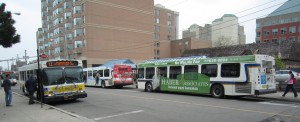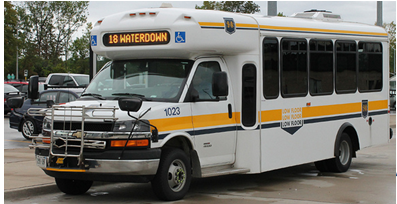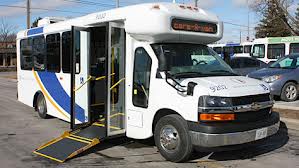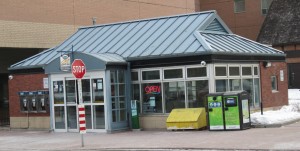 By Susan Lewis
By Susan Lewis
October 2, 2014
BURLINGTON, ON.
There is trouble in paradise – Burlington Transit staff received more than 300 complaints within the first month or two after the drastic changes to the bus routes last November 3rd.
It would be fair to say that since then, there have been a few hundred more calls and e-mails to staff regarding these changes. People want the base network, that took almost 40 years to establish, to be restored.

Transit transfer point in the downtown core.
Before the new base system was implemented, it appears there was no analysis done by any outside consultants nor was there any input asked for from the public or from the bus users.
Obviously, the new base network is not working. City Staff reported that since November, there has been an overall decrease in ridership of 100,000 passengers in the first six months of the new schedule (from 1.7m riders to 1.6m).
The loss of 100,000 passengers equals a loss of approximately $300,000.00 in bus fares to the City’s coffers and it also means the addition of 100,000 more car trips adding to our traffic congestion.
The response to these complaints from our City Councillors has been disappointing. One example: Mayor Goldring saying, “… we have to give people, who may have been inconvenienced somewhat, (time) to get used to the new changes. Hear the man for yourself: Scroll through the web cast to 01:07:02 +/-
Some people completely lost the service they had depended on for years. Some we know of bought their house because of the proximity of transit. To refer to their plight as being “inconvenienced somewhat” and to be told they would get used a lower quality of life in time is insulting and heartless.
The City is planning to add two new Community Buses and the addition of 13,000 hours of additional service on several routes. The changes would cost $1.2m in annual operating expenses and $1.3m for capital. This was proposed during the June 30 Community and Corporate Services Committee meeting, agenda Item #5, Transit Report Card.

Community buses are cheaper to operate – but Burlington Transit hasn’t got the bugs in scheduling worked out yet,
The purpose of a Community Bus is to improve accessibility for people who have mobility limitations, but whose limitations are not severe enough to allow them to qualify for Handi-Van. They’re also intended to reduce demand from more expensive Handi-Van door-to-door services by providing an alternative, more spontaneous travel option.
The existing Community Connection Bus will have service increased from 2 days a week to 5 days. The new hours will be from 9:00 a.m. until 3:00 p.m. The problem with this bus is that it only goes in one direction. If you were at the Seniors Centre and wanted to visit the hospital, you would have to go to Tansley Woods first to get there.
After being in use for less than a year, the City will make a major change to the Route 300. Instead of going across Upper Middle to Brant, it will turn south at Walkers Line and Upper Middle. When routes are changing every few months, a person cannot count on the bus and must therefore find another way of getting around. Your bus could be here today and gone tomorrow.
The City is planning to add two more Community Connection buses to run 5 days a week from 10:00 a.m. to 3:00 p.m. and they will service the South East and South West end of Burlington. All three routes will connect at the Burlington Seniors Centre downtown.

Handi-vans are expensive to operate and difficult to schedule. Repairing roads is cheaper?
We do need to address the needs of our seniors living in retirement communities. A lot of the areas covered by the Community Buses were serviced by the Handi-Van and by the Taxi Scrip program. We ended the Taxi Scrip Service two years ago, it was costing the City $27,000 per year. Many Community Groups have requested that the City bring back the Taxi Scrip program, to no avail.
With the heavy investment in two new Community Buses, it appears that the City is trying to build a brand new system from scratch. The ridership on the current Community Bus has been dismal. To put so much money into this new system proves that the idea of “build it and they will come” doesn’t always work.
During this current City Council’s reign, so many people lives have been affected in a negative way. They had a reliable service and suddenly they didn’t or worse yet, they completely lost a service they had depended on for years and they lost it with very little notice. People often buy their houses based on where the bus service is. The location of the bus routes is important to a community and it’s an important detail in Real Estate ads. Real Estate Agents often advertise “Walk Score” of a City or a neighbourhood.

The downtown core was going to be defined as a mobility hub – city talked about closing the transit depot at the same time.
“Walkable neighborhoods with access to public transit, better commutes, and proximity to the people and places you love are the key to a happier, healthier and more sustainable lifestyle.” Burlington has Walk Score of 54 out of 100. (A score of 25 – 49 is a car dependent city.)
I’ve often heard it said, it’s easier and less expensive to keep a customer than to find a new customer. To quote a former Burlington Councillor, this is a city where you need to “get a car or get out of town.”
How is Burlington going to explain the loss of approximately $300,000.00 in bus fares and the addition of 100,000 more car trips adding to our traffic congestion? It’s not about buses, it’s about people.
So far, the City isn’t listening to the hundreds of complaints from the people of this city.





















Joan,
“The 100,000 less could be an increase to isolation”
During my delegation of Feb. 13, I did suggest that someone my have misinterpreted the phrase, “Keeping seniors in their homes”.
Thomas:
“So if there is 10 people on the #6 and it turns into the #11 the #11 has just lost 10 boardings.”
If the #6 was interlined to become the #11, it would have no effect on the number of boardings. Boardings refer to the physical act of getting on the bus. If the bus is interlined, no one needs to physically get off the bus and then use a transfer to get back on the bus. However, if 10 people were on the #6 and had to get off the bus and then had to use a transfer to get on a another vehicle, that would count as a second boarding. In this case, the number boardings would be 20, not a loss of 10.
“Burlington Transit does not have 100,000 different riders.”
I was quoting Councilor Marianne Meed-Ward’s News Report, entitled “To Council June 30, 6:30pm, City Hall”, (https://ward2news.ca/transit-and-roads/transit-improvements-2015-burlington-city-budget/) which says, “After the changes in November, overall ridership decreased by 100,000 passengers, from 1.7m riders to 1.6m, with boardings per hour down from 25 to 24.” Most people don’t understand the term “boardings” so I avoided using that word altogether. Since I was quoting Councilor Meed-Ward, I used the word passengers in my article. Perhaps you would have preferred a title referring to the loss of 100,000 bus trips.
“BT has an average of 175,000 boardings each month and anywhere between 5,000-7,000 boardings each weekday.”
When you divide 1.6 million by 6 months,the result is 216,667 boardings per month. I can’t address your statement, “anywhere between 5,000-7,000 boardings each weekday” Even Burlington Transit staff, when asked at the June 17 Committee Meeting, couldn’t say how many boardings there were per week day. (I believe the question was asked of the Director of Transit by Councilor Taylor. I’d have to watch the video again to confirm that.) Admittedly, you could be privy to reports I don’t have access to.
“If Burlington Transit did lose 100,000 boardings that would mean BT lost 1087 riders…”
I cannot address your number of 1087. A few Councillors have asked transit staff just how many customers we have lost. Staff said they had no way of tracking that until the new software comes on line in about 14 months. Presently, staff has no such data and they can only rely on periodic surveys. The new software will track how many riders get on and off every bus at every bus stop.
The transit file is a complicated one and it can quite be difficult to handle. As an example, most people don’t know that the City of Burlington has to pay GO $3,300,000 per year because we have GO Stations here. (https://cms.burlington.ca/Asset1995.aspx) The $3.3 million is the amount it was in 2002. I haven’t looked up the current amount. Halton Region used to pay GO but they downloaded most of the cost to the Cities that have the GO service. That money comes out of the Burlington Transit budget. Personally, I think Burlington’s share of the expense is higher than it should be but, I don’t know how the Region came up with the splitting of the costs.
Sometimes I think transit should be handled by outside experts and not a Municipal Council. Probably the majority of the Municipal Councillors in Ontario don’t use the system or even fully understand terminology but yet, they make decisions on how to best to allocate the millions of dollars we put into it. Education matters can also be quite difficult and costly. That’s why we elect Trustees to make decisions on how to spend that budget. They devote all their time to working on that one file
I will also mention that Burlington Transit is not taking consideration into passengers that are already on the bus if the bus turns into another route. So if there is 10 people on the #6 and it turns into the #11 the #11 has just lost 10 boardings.
I don’t think I have ever seen a piece of news so incorrect in my life. Firstly, Burlington Transit does not have 100,000 different riders. I believe you meant boardings. Yes, BT’s ridership has decreased as a result of the many different schedule changes however not to the magnitude you have posted as your headline. BT has an average of 175,000 boardings each month and anywhere between 5,000-7,000 boardings each weekday. I will use myself as an example. I get on the 1/101 and 6 every weekday (I get on a bus 4 times a day). There is 23 weekdays in October so I will account for 92 boardings this month alone for both my morning and afternoon trips. If Burlington Transit did lose 100,000 boardings that would mean BT lost 1087 riders if they also got on a bus 4 times a day during a weekday in October.
‘Here’ the man for yourself? You mean ‘Hear’? Journalism 101.
Oops – fixed that – Thank you
The 100,000 less could be an increase to isolation. Accessibilty and all inclusive does not mean increase isolation which was a problem even prior to November. Sad!